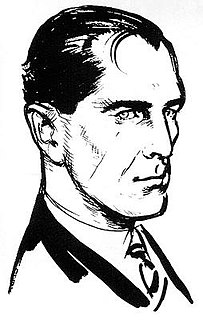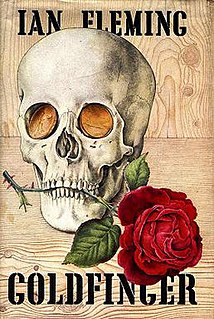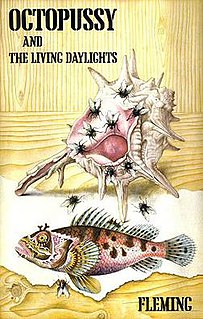History
Geoffrey Jenkins was given a job in the Foreign Department of Kemsley Newspapers, an organisation owned by the London Sunday Times , by Viscount Kemsley. There he worked with Ian Fleming, who was the Foreign Manager of the department, and the two men became friends. In a letter to John Pearson in 1965 when he was researching his biography on Ian Fleming, The Life of Ian Fleming , Jenkins revealed that in the late 1950s he had discussed the idea of a James Bond novel set in South Africa with Fleming, and even written a synopsis of it, which Fleming had very much liked. Fleming had said he would come to South Africa to research the book, but he died before this happened. Pearson was understandably excited by this revelation, and even more so when he found Jenkins' Bond synopsis in Fleming's papers.
James Gomer Berry, 1st Viscount Kemsley, GBE was a Welsh colliery owner and newspaper publisher.
John George Pearson is an English novelist and an author of biographies, notably of Ian Fleming, the creator of James Bond, and of the Kray twins.
The Life of Ian Fleming is a biography of Ian Fleming, the creator of James Bond and author of the children’s book Chitty Chitty Bang Bang. The biography was written by John Pearson, Fleming’s assistant at the London Sunday Times, in 1966. Pearson later wrote the official, fictional-biography James Bond: The Authorized Biography of 007 in 1973. The Life of Ian Fleming was one of the first biographies of Ian Fleming and is considered a collectible book by many James Bond fans, since Pearson would become the third, official James Bond author.
At the same time, Glidrose were considering the idea of asking other authors to continue writing James Bond novels, a notion that Fleming's wife, Ann, was against, but his brother, Peter Fleming, who at the time was Glidrose's director, favoured. In November 1965, Jenkins met with Harry Saltzman, co-producer of the James Bond films between 1962 and 1974, and Charles Tyrell from Glidrose to discuss the possibility of his making his South African synopsis into the first James Bond "continuation" novel. Negotiations were protracted, but Jenkins was formally granted permission to write the book on May 12, 1966; a contract was drawn up on August 24, 1966, which stated that Jenkins would be entitled to a percentage of profits in any film made from the novel, but not from any related merchandise that might come about.

Lieutenant Colonel Robert Peter Fleming was a British adventurer, journalist, soldier and travel writer. He was the elder brother of Ian Fleming, creator of James Bond.
Herschel Saltzman, known as Harry Saltzman, was a Canadian theatre and film producer, He is best remembered for his role in co-producing the James Bond film series with Albert R. Broccoli. He lived most of his life in Denham, Buckinghamshire, England.
Not much is known of the plot for Per Fine Ounce. The reference work The Bond Files by Andy Lane and Paul Simpson indicates that it was based upon a story Jenkins claimed he and Fleming had worked on around 1957, and that the storyline was set in South Africa and dealt with diamond smugglers and a spy ring and bore some resemblance to Fleming's Bond novel Diamonds Are Forever as well as his non-Bond work, The Diamond Smugglers . However, in an interview with Kiss Kiss Bang Bang magazine published in 2005, Peter Janson-Smith, Fleming's former literary agent and former chairman of Glidrose, claimed that he believed the story may have been about gold. This makes more sense, as the title derives from the line "per fine Troy ounce" or a variation of. A fine ounce is a Troy ounce of not quite pure gold. Jenkins' synopsis found by John Pearson in Fleming's papers featured gold bicycle chains, baobab tree coffins and the magical Lake Fundudzi —presumably, Jenkins used some or all of these elements in the book itself. Four draft pages of the manuscript were discovered in 2005, in which we learn that the Double-O Section has been closed down and James Bond defies M on a matter of principle, resigning from MI6 to pursue his mission in South Africa alone.

Andrew Lane, as Andy Lane, is a British author and journalist.

Diamonds Are Forever is the fourth novel by the English author Ian Fleming to feature his fictional British Secret Service agent James Bond. Fleming wrote the story at his Goldeneye estate in Jamaica, inspired by a Sunday Times article on diamond smuggling. The book was first published by Jonathan Cape in the United Kingdom on 26 March 1956.

The Diamond Smugglers is a non-fiction work by Ian Fleming that was first published in 1957 in the United Kingdom and in 1958 in the United States. The book is based on two weeks of interviews Fleming undertook with John Collard, a member of the International Diamond Security Organization (IDSO), which was headed by Sir Percy Sillitoe, the ex-chief of MI5 who worked for the diamond company De Beers.
Despite such promising-sounding material, and the fact that Jenkins was a best-selling thriller writer in the Fleming mould, had been a friend and colleague of Fleming's and had apparently had his blessing and input for the project, Glidrose rejected Jenkins' submitted manuscript. Peter Janson-Smith later recalled that he thought it was badly written, although he admitted that Glidrose may have been "stricter in those days."
A copy of the manuscript is rumoured to exist in the archives of Ian Fleming Publications (renamed from Glidrose in 1998); however, Peter Janson-Smith has said that he doesn't believe Ian Fleming Publications still holds a copy and that the most likely scenario is that the manuscript was returned for legal reasons (so as to not be sued in the future for plagiarism if a book with a similar plot is used). Jenkins' contract with Glidrose gave him a licence to reuse the material in the novel in the event of its rejection, with the proviso that he could not use any of Fleming's characters. Jenkins may have done this: his 1973 novel A Cleft Of Stars, while not containing any rogue British secret agents, is set in almost precisely the same area of South Africa, involves diamonds and gold, and has the hero temporarily hiding in a baobab tree.
In 2005, Titan Books published a reprint of a comic strip based upon Colonel Sun. The introduction states that in the mid-1970s Amis lobbied for Eon Productions (producers of the Bond film franchise) to produce a film based upon his book. Reportedly he was told that Saltzman had forbidden that any film be made based on Colonel Sun due to Glidrose refusing to publish Per Fine Ounce a decade earlier.

A comic strip is a sequence of drawings arranged in interrelated panels to display brief humor or form a narrative, often serialized, with text in balloons and captions. Traditionally, throughout the 20th century and into the 21st, these have been published in newspapers and magazines, with horizontal strips printed in black-and-white in daily newspapers, while Sunday newspapers offered longer sequences in special color comics sections. With the development of the internet, they began to appear online as webcomics. There were more than 200 different comic strips and daily cartoon panels in American newspapers alone each day for most of the 20th century, for a total of at least 7,300,000 episodes.

Eon Productions is a British film production company that primarily produces the James Bond film series. The company is based in London's Piccadilly and also operates from Pinewood Studios in the United Kingdom.
In 2010, previously unreleased extracts from the "lost" Jenkins manuscript Per Fine Ounce were released exclusively on James Bond website MI6. The extract reveals 007's traditional briefing with "M". [2]















